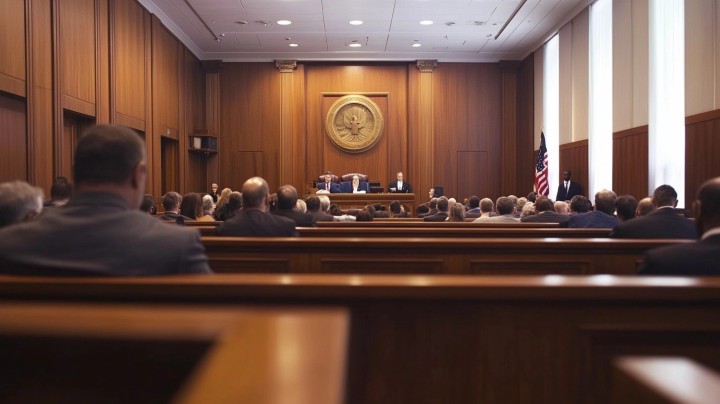Pretrial release is a critical concept within the criminal justice system, affecting defendants, victims, and the broader community.
The History of the Bail Bond System
Bail bonds have played a crucial role in legal systems around the world, ensuring that defendants can secure their release from jail while awaiting trial.
How Do Bail Bond Agencies Make Money?
Bail bond agencies, also known as bail bond companies or bail bondsmen, play an important role in the criminal justice system.
What Types of Collateral Are Accepted for Bail Bonds?
Finding out that you or someone you care about is in jail can be really frightening. The main goal is to get them out of that cold, scary cell and back home as soon as possible.
How to Find a Bail Bond Agent in Texas
Introduction
Navigating the bail bond process in Texas can be daunting, especially during stressful times. This guide aims to simplify the task of finding a competent and trustworthy bail bond agent in Texas, ensuring that you or your loved ones can secure release from custody with minimal hassle.
Understanding Bail Bonds
A bail bond is a form of surety provided by a bail bond agent that allows a defendant to be released from jail while awaiting trial. In Texas, the process involves a legal agreement backed by an insurance company. It’s crucial to understand the types of bail bonds available, such as cash bonds, surety bonds, and personal bonds, each suiting different situations.
Legal Requirements for Bail Bond Agents in Texas
Bail bond agents in Texas must be licensed, which ensures they meet specific standards of knowledge and ethics. The Texas Department of Insurance regulates these agents, maintaining oversight and compliance with state laws.
Starting Your Search for a Bail Bond Agent
Begin by consulting local directories or online platforms that list bail bond agents. Recommendations from attorneys or those with firsthand experience in the judicial system can also be invaluable.
Evaluating Bail Bond Services
When choosing a bail bond agent, consider their experience, reputation, and the clarity of their fee structure. Ask potential agents about their process, availability, and typical time frames. Transparency is key.
Online Reviews and Testimonials
Reviews and testimonials offer insights into the experiences of previous clients with specific bail bond agents. Look for feedback that mentions professionalism, efficiency, and support.
Bail Bond Costs and Payments
Understanding the fee structure is crucial. Most bail bond agents in Texas charge around 10% of the bail amount as their fee, which is non-refundable. Ensure you are clear about any additional charges that may apply.
Bail Bond Agent Selection Criteria
Select an agent who is responsive, knowledgeable, and respectful. Be wary of those who do not provide clear information or who seem overly aggressive in their marketing.
What to Do After Contacting a Bail Bond Agent
Once you select an agent, they will guide you through the paperwork and legal procedures. It’s important to understand the obligations involved, including ensuring that the defendant appears at all required court dates.
Alternatives to Bail Bonds
Consider other options such as a personal recognizance bond, where the defendant is released based on a promise to appear in court, depending on the case and jurisdiction.
Legal Protection and Rights
It’s vital to understand your rights throughout the bail process, including the right to fair treatment and the right to know all your legal options.
Frequently Asked Questions
- How do I verify the license of a bail bond agent?
- What happens if the defendant does not meet court obligations?
- Are there any refund policies for bail bond fees?
Conclusion
Selecting the right bail bond agent in Texas is crucial for ensuring a smooth and fair process. With the right knowledge and resources, you can make informed decisions that protect your rights and financial interests.
[ninja_form id=6]
What are the typical bail bond fees in Texas?
Introduction
The process of obtaining a bail bond in Texas can seem daunting, especially during the stressful moments following an arrest. Understanding the typical fees associated with bail bonds is crucial for anyone who finds themselves or a loved one needing to navigate this system. This article explores the typical bail bond fees in Texas, providing a clear breakdown of costs, the role of bail bond agents, and additional considerations to keep in mind.
What is a Bail Bond?
A bail bond is essentially a financial arrangement made by a bail bonding agency on behalf of the defendant. This agreement ensures the court that the defendant will appear for trial. In Texas, as in other states, bail bonds can come in various forms such as cash bonds, surety bonds, or property bonds, each serving the same purpose but involving different elements of risk and financial obligation.
How Bail Amounts Are Determined in Texas
In Texas, bail amounts are not randomly set but are influenced by several factors including the severity of the charge, past criminal history, the defendant’s ties to the community, and their perceived flight risk. Texas utilizes a bail schedule which provides guidelines, but the final amount can vary significantly based on judicial discretion.
Standard Bail Bond Fees in Texas
Typically, bail bond fees in Texas amount to about 10% of the total bail set by the court. This fee is non-refundable and compensates the bail bond agent for the risk they undertake. For instance, if the bail is set at $20,000, the bail bond fee would be $2,000. It’s important to note that this rate can vary slightly based on the nature of the charges and the policies of the individual bail bond agency.
Additional Costs Associated with Bail Bonds
Beyond the standard fee, there might be additional costs involved when securing a bail bond. These can include processing fees, administrative charges, and potentially, charges related to collateral management or credit card processing. These fees should be disclosed upfront by the bail bond agent, ensuring transparency.
Examples of Bail Bond Fees by County
Fees can also vary by location within Texas. For example, bail bond fees in major counties like Harris, Dallas, and Travis might differ slightly due to varying administrative demands and the local bail schedules. These variations underscore the importance of consulting with a local bail bond agent to get accurate information relevant to the specific county.
Role of Bail Bond Agents
Bail bond agents play a crucial role in the bail process. They provide the funds necessary for a defendant’s release, under the agreement that the defendant will appear at all required court proceedings. In Texas, bail bond agents must be licensed and comply with stringent regulations to operate, ensuring they provide reliable and ethical services.
Benefits of Using a Bail Bond Service
Choosing to use a bail bond service offers significant advantages. Most notably, it allows the defendant to be released from jail without having to pay the full amount of bail upfront. This can be particularly beneficial for individuals who cannot afford the total bail amount. Additionally, bail bond services can expedite the release process, often getting the defendant released within a few hours.
Risks and Considerations When Choosing a Bail Bond Agent
However, there are risks involved. Choosing an unscrupulous bail bond agent can lead to complications, such as hidden fees or unethical practices. It is vital to select a reputable agent, ideally one with positive reviews and a strong track record.
Alternatives to Bail Bonds in Texas
It’s also worth considering alternatives to bail bonds, such as release on personal recognizance, where the defendant is released based on their promise to appear in court. This option is typically available for less serious charges and to individuals with strong community ties and no previous criminal history.
Legal Framework Governing Bail Bonds in Texas
The legal framework surrounding bail bonds in Texas is governed by both state statutes and local regulations. Recent legislative changes and updates continue to shape the practice, aiming to make the bail process fairer and more consistent across the state.
Understanding Bail Bond Contracts
When entering into a bail bond contract, it is crucial to understand all the terms and conditions. These contracts can be complex, and ensuring you know every aspect, including obligations and potential penalties for non-compliance, is essential.
Impact of Not Paying Bail Bond Fees
Failing to pay bail bond fees can result in severe consequences, not just for the defendant but also for any cosigners on the agreement. Bail bond companies may take legal action to recover the money, which can include suing for the unpaid amount or employing collection agencies.
FAQs on Bail Bonds in Texas
- What is the least expensive bail bond fee I can expect in Texas?
- Can bail bond fees be negotiated?
- Are there any additional hidden fees I should be aware of?
- What happens if the defendant skips bail?
- How do I choose a reliable bail bond agent?
- What are my rights when using a bail bond service?
How to Find and Evaluate Bail Bond Services
Finding and evaluating bail bond services requires careful research. Checking online reviews, seeking recommendations from legal professionals, and comparing services offered by various agents can help ensure you choose a reliable and fair service.
Success Stories: How Bail Bonds Helped
Many individuals have benefited from the services of bail bond agents, enabling them to resume their daily lives while preparing for court appearances. These success stories often highlight the efficiency and supportive nature of experienced bail bond agents.
Conclusion
Understanding the typical bail bond fees in Texas is essential for anyone navigating the legal system. By being informed about the costs, processes, and legal implications, defendants and their families can make more informed decisions, ensuring a smoother and less stressful experience during legal proceedings.
[ninja_form id=6]
Can Bail Bond Fees Be Refunded in Texas?
Understanding the financial implications of bail bonds is crucial, especially when it comes to knowing whether you can get a refund on bail bond fees in Texas. Here’s what you need to know about the refund policies and how they apply in different scenarios.
Understanding Bail Bond Fees in Texas
Bail bond fees, often referred to as premium payments, are the non-refundable charges paid to a bail bond service for securing the release of a defendant. In Texas, as in most states, these fees are typically set at around 10% of the total bail amount. This fee compensates the bail bond agent for the risk they undertake and the service provided in posting the full bail amount on behalf of the defendant.
The Non-Refundable Nature of Bail Bond Fees
The fundamental aspect to understand about bail bond fees in Texas is that they are non-refundable. Once paid, these fees serve as the bail bond company’s income for the service of posting bail and are not returned, regardless of the outcome of the case—whether the charges are dropped, the case is dismissed, or the defendant is found innocent.
Scenarios Involving Bail Bond Fee Payments
Case Dismissal and Fee Refund
Many individuals wonder if their bail bond fees will be returned if the case is dismissed shortly after the arrest. However, since the bail bond service has already fulfilled its obligation by providing the bail to secure the defendant’s release, the premium is considered earned. This policy holds even if the defendant was only out on bail for a short period before the case was dismissed.
Collateral Return on Bail Bonds
While the bail bond fee itself is non-refundable, any collateral put up by the defendant or their supporters to secure the bond is returnable. Collateral can include property, vehicles, jewelry, or other valuable items and is returned after the conclusion of the court proceedings, assuming all conditions of the bail have been met, including the requirement for the defendant to appear at all scheduled court dates.
Exceptions and Special Considerations
Overpayment and Clerical Errors
In rare instances where there may be an overpayment on the bail bond fee due to a clerical error, the excess amount is refundable. It’s important for those engaging with bail bond services to keep detailed receipts and transaction records to ensure that any discrepancies can be addressed and rectified.
Ethical Practices in the Bail Bond Industry
Reputable bail bond agents in Texas adhere to strict ethical standards and are regulated by state laws that dictate the handling of bail bond fees. Consumers are encouraged to work with well-established, licensed bail bond services to avoid any unethical practices and to ensure transparency in all financial transactions related to bail bonds.
Conclusion
In Texas, bail bond fees are a non-refundable part of the agreement between a defendant (or their representative) and the bail bond company. While the outcome of the case does not influence the refundability of these fees, understanding the conditions and terms of bail bond agreements can help manage expectations and financial planning during the legal process. Always consult with a trusted bail bond service to clarify any questions or concerns regarding bail bond agreements and fee structures.
Secure Your Freedom with Delta Bail Bonds: Texas’ Trusted Bail Bond Agency
When you or a loved one needs assistance with bail in Texas, choose Delta Bail Bonds—the most respected and reliable bail bond agency in the state. At Delta, we understand the urgency and sensitivity required during these challenging times. Our commitment to fast, professional, and confidential service ensures that you receive the support you need without delay.
[ninja_form id=6]
Posts pagination
Banner video popup
This will close in 0 seconds









